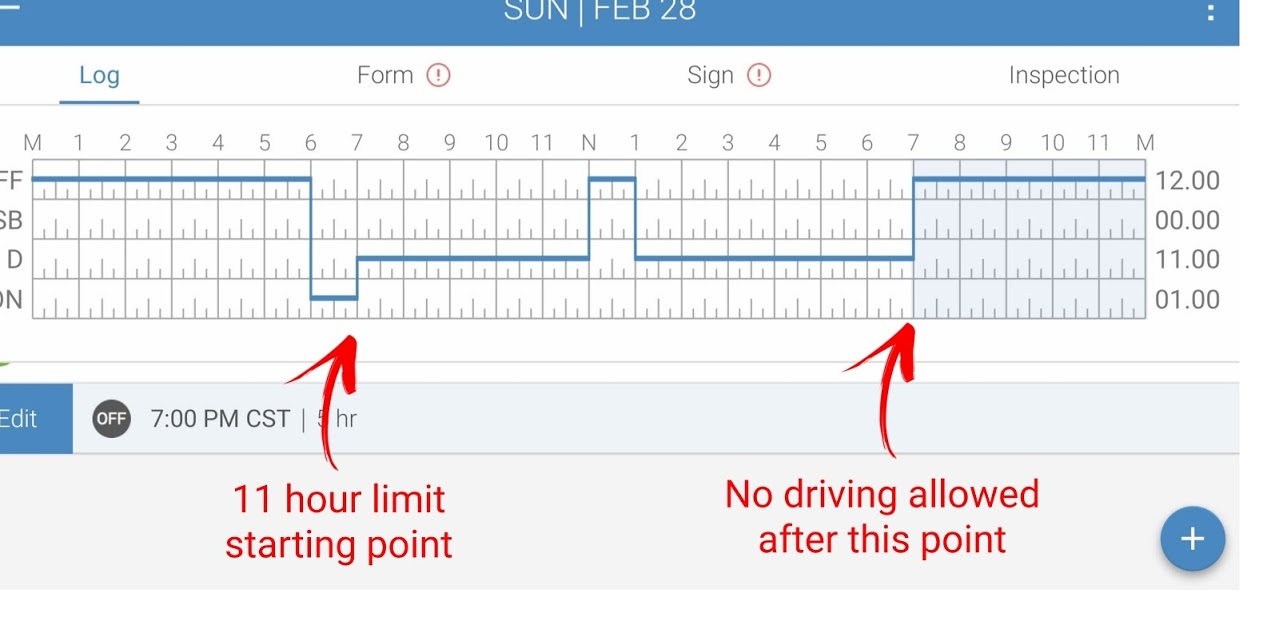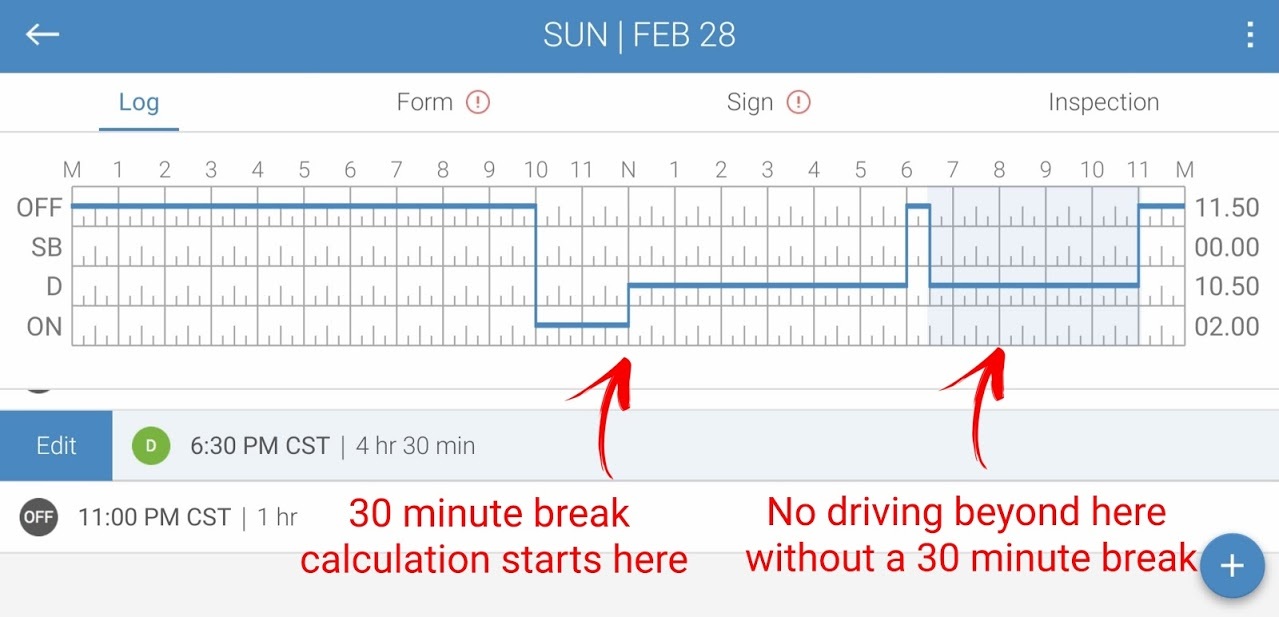Note: Your are not logged in. We can not keep your scores or track your progress unless you Register and Log In
11-hour Driving Limit
During the 14-consecutive-hour, on-duty period, you can drive your truck for up to 11 total hours. Once you have driven 11 hours, you have reached the driving limit and must be off duty for another 10 consecutive hours before driving again. You can think of this as a window of opportunity. You have a 14-hour window of opportunity, in which you can drive your truck for 11 hours. Both the 14-hour clock and the 11-hour clock are reset after you log 10 hours off duty.
11-hour Driving Limit Example:

After taking 10 consecutive hours off, you begin work at 6:00 a.m. and drive from 7:00 a.m. until 7:00 p.m. with a one hour break from noon to 1:00 p.m. (total of 11 hours driving). You cannot drive again until you have accumulated at least 10 consecutive hours off duty. You may do other work after 7:00 p.m., but you cannot do any more driving of a CMV.
30-minute Break Rule
If you drive 8 consecutive hours with no breaks, you can not drive a CMV until you take a 30-minute break. You may perform other on-duty tasks, but you cannot drive.
The 30-minute break must be a break from driving, but you can use those 30 minutes any way you like. You may:
- Go off duty
- Go to the sleeper berth
- Perform on-duty task like a pre-trip inspection or fueling
- Use any combination of on-duty and off-duty time
Any combination of on-duty, off-duty, and sleeper berth time makes up a legal break. You could take 15 minutes on duty time fueling, then another 15 minutes off duty to run into the truck stop to relieve your bladder and purchase a snack and a drink. That would legally suffice for your 30-minute break. As long as you're not driving, you're ok.
If you take some on-duty time at the beginning of your shift, it does not count against your eight hours of driving time. You might start your day at 4:00 a.m. by getting your truck loaded, but you don't start driving until 8:00 a.m. If that is the case, you can drive for up to 8 hours (or until 4:00 p.m.) before being required to stop and take your 30-minute break. Of course, you can take it earlier if you choose. This is just an example to help you understand the structure of the rule. You can not drive more than 8 consecutive hours without taking a 30-minute break. Here is an example of the 30-minute break provision:

In the above example, the driver first went on duty at 10:00 a.m. That is not the starting point of his calculation for his 30-minute break. He started driving at noon. That becomes the starting point for calculating when he needs to take his 30-minute break. If the driver doesn’t stop for the next 8 hours he must take at least a 30-minute break by 8:00 p.m. (8 hours later) in order to continue driving a CMV. If you do not take a break by 8:00 p.m., you can not legally drive. The driver can perform other on-duty tasks, but cannot drive. In this example, however, a 30-minute, off-duty break was taken from 6:00 p.m. to 6:30 p.m. so the driver was legally allowed to continue driving.
The 60/70-hour Duty Limit
Finally, you have the 60/70-hour limit. The 60-hour limit is based on a 7-day period, the 70-hour limit is based on an 8-day period. The calculation of this limit includes both driving time and on duty time, combined.
This limit is sometimes thought of as a weekly limit. However, this limit is not based on a set week, such as Sunday through Saturday. The limit is based on a rolling 7-day or 8-day period. The oldest day's hours drop off at the end of each day when you calculate the total on-duty time for the past 7 or 8 days. For example, if you operate on a 70-hour/8-day schedule, the current day would be the newest day of your 8-day period and the hours you worked 9 days ago would drop out of the calculation.
You are required to follow one of these two "weekly" limits:
The 7-day/60-hour Limit
If your company does not operate vehicles every day of the week, you are eligible to use the 7-day / 60-hour limit. By using this limit, you are not allowed to drive after you’ve been on duty for 60 hours during any 7 consecutive days. Once you reach the 60-hour limit, you will not be able to drive again until you have dropped below 60 hours for a 7-consecutive-day period. You may do other work, but you cannot do any more driving until you are off duty enough days to get below the limit. Any other hours you work, whether they are for a motor carrier or someone else, must be added to the total.
The 8-day/70-hour Limit
If your company operates vehicles every day of the week, you will use the 70-hour / 8-day schedule. This means that you are not allowed to drive after you've been on duty for 70 hours in the previous 8 consecutive days. Once you reach the 70-hour limit, you will not be able to drive again until you have dropped below 70 hours of accumulated on duty time for the previous 8-consecutive-day period. You may do other work, but you cannot do any more driving until you drop below the limit. Any other hours you work, whether they are for a motor carrier or someone else, must be added to the on duty total.
Multiple-Choice Questions:
Which of the following is NOT a legitimate 30-minute break?
- You take 15 minutes in the sleeper berth and 15 minutes driving
- You spend 30 minutes counting cargo as the dock workers load it into your trailer
- You spend 15 minutes in the sleeper berth and 15 minutes fueling the truck
- You take 15 minutes in the sleeper berth and 15 minutes off duty
During the 14-consecutive-hour, on-duty period, you can only drive your truck for up to how many total hours?
- 10.5
- 14
- 10
- 11
Which of the following is NOT true about taking a required 30-minute break?
- After 8 consecutive hours of driving, you may perform other on-duty tasks, but you cannot drive
- If you drive 8 consecutive hours with no breaks, you may not drive a CMV until a 30-minute break is taken
- The 30-minute break can be taken as an off-duty break or it can also be satisfied during a time period of performing on-duty tasks.
- You can complete the 30 minute break using any combination of on-duty, off-duty, or driving time
Which clock is reset after taking 10 consecutive hours off duty?
- No clocks are reset by 10 consecutive hours off duty
- Only the 14 hour clock
- Both the 11 hour and 14 hour clocks
- Only the 11 hour clock
You start your pre-trip inspection at 6:00 am. Then you get fuel and do some paperwork. You begin driving for the day at 8:00 am. How long can you drive before you must take a 30-minute break?
- Until 4:00 pm
- Until 2:00 pm
- Until 12:00 pm
- Until 11:00 am
If your company operates vehicles every day of the week, which logbook schedule will you use?
- Either the 60-hour / 7 day or the 70 hour / 8 day schedule
- 60-hour / 7 day schedule
- All these are correct
- 70-hour / 8-day schedule.
When calculating your total time for the 60-hour or 70-hour logbook rule, which factors are considered in the calculation?
- Drive time only
- Drive time and on duty time
- Drive time, on duty time, and sleeper berth
- On duty time only
You operate on the 70-hour/8 day logbook schedule and you've used up all of your 70 hours. Which of the following can you legally do without any of your 70 hours available?
- Wait on-duty for the mechanics to service the vehicle
- Take an online safety course for your company
- Do a pre-trip inspection on the vehicle
- You can do all these
You begin your pre-trip inspection at 7:00 am. After that, you drive for only 7 hours with a mix of on-duty time, rest breaks, and driving time. You are not using the split sleeper berth rule. You finish driving at 10:00 pm. Is this legal according to the 11-hour and 14-hour rules?
- No. You can not drive past 8 pm according to the 11-hour rule
- Yes, this was legal because you only drove 7 hours out of the 11-hour window
- Yes, this was legal because you finished driving within the 14-hour window
- No. You can not drive past 9:00 pm according to the 14-hour rule which began at 7:00 am
If you drive ____ consecutive hours with no breaks, you can not drive a CMV until a 30-minute break is taken:
- 14
- 11
- 8
- 4
Complete!
You can Return To The Table Of Contents







 TT On Facebook
TT On Facebook